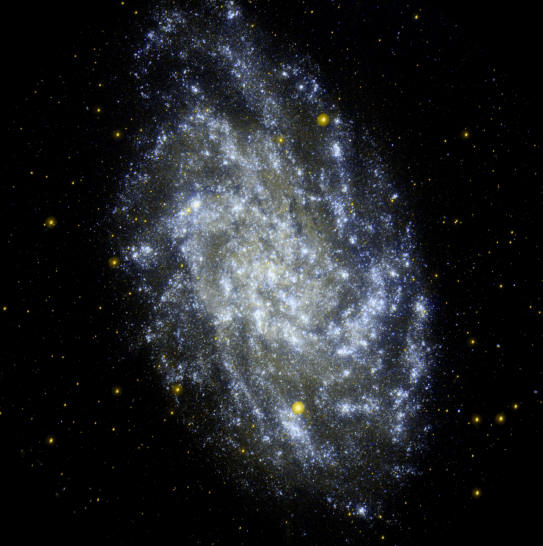For October 2015, the moon is last quarter on October 4th, and waning in the morning sky for the first two weeks of the month. The waning crescent passes just one degree south of Venus on the morning of October 8th, then passes Mars and Jupiter on the following dawn. The New Moon is October
13th, and the crescent moon the following evening marks the Muslim New Year, 1437 AH. The waxing crescent passes 3 degrees north of Saturn on October 16th.
The first quarter moon on October 20th will be setting at midnight, and thus not interfere with the peak of the Orionid Meteor Shower the following morning. This is debris from Comet Halley, and about a meteor every 3-4 minutes seem to come out of Orionís head. The full moon, the Hunterís
Moon, is on the evening of October 27th, so the moon will be waning gibbous, and not rising until about 11 PM on Halloween, a little late for viewing by the family out walking for treats, alas.
Saturn is low in the SW evening sky in October, just west of the claws of Scorpius. Saturn will be lost in the Sunís glare by monthís end. Jupiter and Venus dominate the dawn sky, and have a close conjunction on the morning of October 25th, with brighter Venus passing just a degree north of
Jupiter. The red planet Mars is much fainter than these two, but is also in the dawn, and passes only a moon diameter north of Jupiter on the morning of October 17th, so some good photo ops for early rising planet watchers this month.
The Big Dipper falls lower each evening. By the end of October, it will be only the three stars in the handle of Dipper still visible in the northwestern twilight. By contrast, the Little Dipper, while much fainter, is always above our northern horizon.
To the southwest, Antares and Scorpius also set soon after twilight, and will be gone by monthís end. East of the Scorpionís tail is the teapot shape of Sagittarius, which marks the heart of our Milky Way galaxy. Looking like a cloud of steam coming out of the teapotís spout is the fine
Lagoon Nebula, M-8, easily visible with the naked eye. This stellar nursery is ablaze with new stars and steamers of gas and dust blown about in their energetic births. In the same binocular field just north of the Lagoon is M-20, the Trifid Nebula. Many other clusters visible in binoculars as you sweep northward
along the Milky Way, and are plotted on the sky map for the month.
The brightest star of the northern hemisphere, Vega dominates the sky overhead. To the northeast of Vega is Deneb, the brightest star of Cygnus the Swan. To the south is Altair, the brightest star of Aquila the Eagle, the third member of the three bright stars that make the Summer Triangle
so obvious in the NE these clear autumn evenings. To the east of Altair lies tiny Delphinus, a rare case of a constellation that does look like its namesake.
To the east, the square of Pegasus is a beacon of fall. South of it lies the only bright star of Fall, Fomalhaut. If the southern skies of Fall look sparse, it is because we are looking away from our Galaxy into the depths of intergalactic space. The constellation Cassiopeia makes a striking
W, rising in the NE as the Big Dipper sets in the NW. Polaris lies about midway between them. She contains many nice star clusters for binocular users in her outer arm of our Milky Way, extending to the NE now. Her daughter, Andromeda, starts with the NE corner star of Pegasusíí Square, and goes NE with two more
bright stars in a row. It is from the middle star, beta Andromeda, that we proceed about a quarter the way to the top star in the W of Cassiopeia, and look for a faint blur with the naked eye. M-31, the Andromeda Galaxy, is the most distant object visible with the naked eye, lying about 2.5 million light years
distant. It is a bigger version of our own Galaxy, which it may collide with about three billion years from now. It is a good season to meet another neighbor, the Pinwheel galaxy, M-33, just south of Andromeda in Triangulum. Faintly visible with the naked eye under really dark skies, it is easy in binocular and is
beautifully revealed in our featured astrophoto of the month, and another spiral like our own Milky Way.

Below Andromeda is her hero, Perseus. In his hand is a star most appropriate for Halloween, Algol. This star "winks" at us for six out of every 70 hours, which Arabic astronomers centuries ago found spooky, hence naming it "the ghoul" . We know today it is an eclipsing binary system, with
the larger, cooler orange star covering 80% of its smaller, hotter neighbor during the "wink". At the foot of Perseus, the hero of "Clash of the Titans" is the fine Pleiades star cluster, the "seven sisters" that reveal hundreds of cluster members in large binoculars. This might be the best object in the sky for
binocular users.
Winter will be coming soon, and in the NE we see yellow Capella rising. It is the brightest star of Auriga the Charioteer, and pair of giant stars the same temperature as our sun, but at least 100X more luminous and about 10X larger than our sun. It lies about 43 light-years distant. A
little farther south, below the Pleiades, orange Aldebaran rises. It is the eye of Taurus the bull, with the V shaped Hyades star cluster around it making the head of the bull. This colorful giant star is only 2/3 as hot as our yellow sun, but 44X times larger and at 65 light years distant, one of the closest of
these monster stars.